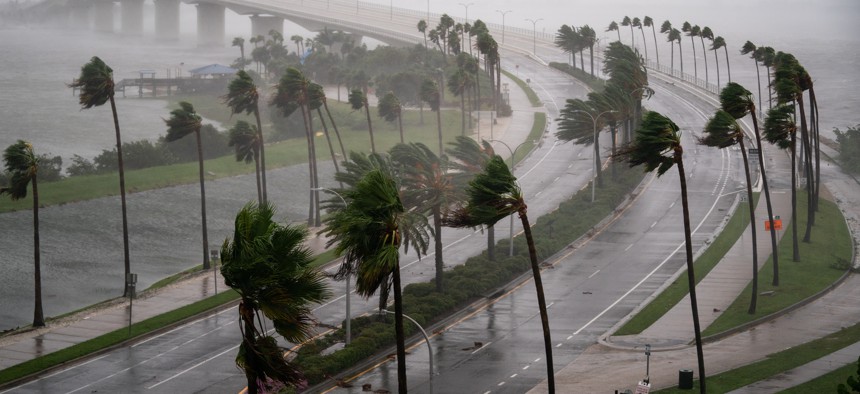Treasury expands the uses of ARPA funding

Hurricane Ian slams into west coast of Florida on September 28, 2022. Sean Rayford / Stringer / Getty Images
Under interim rules, the federal agency would allow state and local governments to spend coronavirus relief money on natural disasters, additional transportation projects and housing, among other uses.
With states and cities still trying to figure out how to use some of the $350 billion in American Rescue Plan Act dollars they’ve received, the Treasury Department is giving them more spending options.
While the rule is not yet final, it does allow governments to spend the funds from the 2021 coronavirus relief package in a variety of new ways. The costs, though, have to have been incurred on or after Dec. 29, 2022, a Treasury official said. Those options include:
- Allowing governments to use money under the ARPA State and Local Fiscal Recovery Funds program to deal with natural disasters, whether it be preparing for an impending storm or recovering from one. Those costs could include providing temporary housing or food assistance and fighting fires or flooding.
- Allowing governments to use unspent ARPA dollars to add to funding they’re already getting for projects like the Surface Transportation Block Grant Program, the Highway Safety Improvement Program and the Charging and Fueling Infrastructure Discretionary Grant Program. The money, for example, can’t be used to replace state funding for a project.
- Allowing state and local governments to use ARPA money for projects that are not receiving federal funding, but fit the requirements for the RAISE program. Among the projects the program is currently funding are the building of a new bridge over a rail line in Tucson, Arizona; the construction of a bike and pedestrian bridge between Virginia and Washington, D.C.; the revitalization of a waterfront in the Virgin Islands; and the replacement of a 60-year-old ferry in Washington state.
- ARPA funds could be used to repay the federal government money owed under the Transportation Infrastructure Finance and Innovation Act loan program.
- And state and local governments could use the money for projects that meet the requirements for Community Block Development Grants, or CBDG, including acquiring certain properties for a public purpose, or rehabilitating or building new public facilities and private utilities.
While states and cities would have more ways to spend the money under the proposed rule, they would have a little less time to spend it.
Under ARPA, governments have until Dec. 31, 2024, to decide if they want to spend the money on the relief packages’ original purposes. They have to spend that money by Dec. 31, 2026.
But if governments want to use the funds for surface transportation, to deal with natural disasters or CDBG projects, they have to spend the funds by Sept. 30, 2026.
Brookings Metro, which has been tracking how local governments have been using ARPA funds, found that 39% are spending it on government operations. Local governments are spending about 11% of their funds each on infrastructure, housing and public health.
According to the Treasury Department, it has already sent 99.99% of the funding to about 30,000 state, local, and Tribal governments.
Though figures for all governments were not available, the Treasury Department noted that states and larger cities have already decided how to spend the vast amount of the money, about 80%, as of March 31. That leaves about a fifth of the money undedicated.
But while the new rule gives more options, Michael Gleeson, the National League of Cities’ legislative director of finance, administration and Intergovernmental relations, noted in a recent blog post that the Treasury Department is also laying out some “potentially burdensome strings to using the money.”
Indeed, the agency said that each of the new ways that the ARPA dollars can be used has its own requirements.
“Recipients should first determine which eligible use category a potential use of funds fits within, then assess whether the potential use of funds meets the eligibility standard or criteria for that category,” the department advised.
Governments hoping to use the ARPA funds to augment the funds they are already receiving for a transportation project, for example, have to check with the transportation department before spending the money, according to the rule.
A particular hardship, Gleeson wrote, is that transportation and CDBG projects have to meet requirements under the National Environmental Policy Act.
Despite being eligible for funding, projects “may still be subject to limitations or prohibitions as a result of the application of other environmental statutes,” he wrote.
Kery Murakami is a senior reporter for Route Fifty, covering Congress and federal policy. He can be reached at kmurakami@govexec.com. Follow @Kery_Murakami
NEXT STORY: Transit agencies scramble to piece together funding as ‘fiscal cliff’ looms






